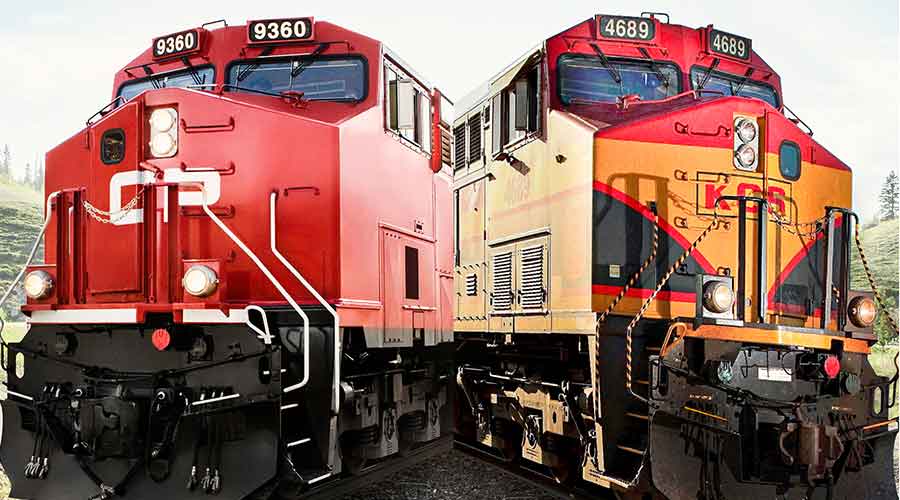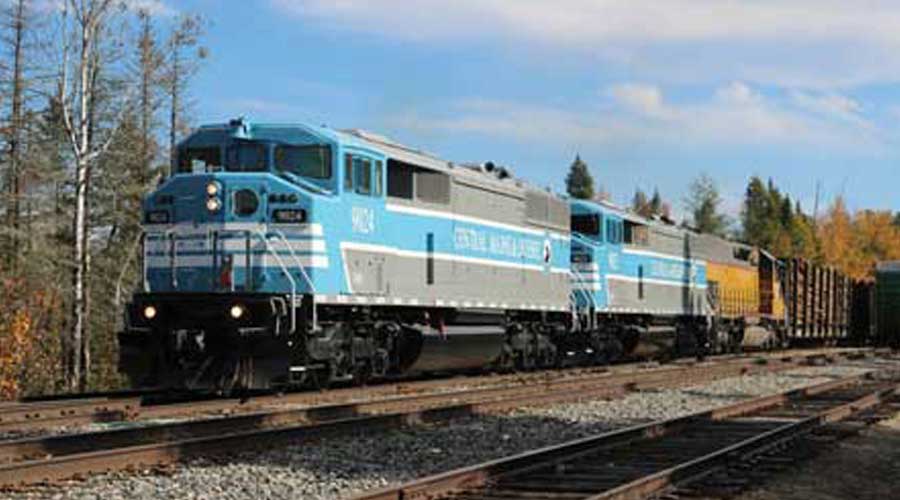Stay updated on news, articles and information for the rail industry
August 2014
Rail News: Canadian Pacific
Canadian Pacific's Keith Creel: A stickler for superior service (profile)
— by Jeff Stagl, Managing Editor
Keith Creel long has been a believer that an extremely well-run railroad is more fluid, reliable and profitable. Since he was appointed Canadian Pacific's president and chief operating officer 18 months ago, Creel has been trying to turn CPers into believers that the Class I — which had been struggling both operationally and financially for several years — could become a well-oiled railroad.
Creel, 46, has served as Chief Executive Officer E. Hunter Harrison's right-hand man at CP in trying to instill reliable operational performance, forge an operating-focused management team and engage employees in performing tasks more consistently. The railroad's second-quarter financial and operational results released on July 17 revealed some fruits born from those efforts.
Figures from what constituted the strongest second-quarter financial performance in the Class I's history show total revenue climbed 12 percent to $1.7 billion, operating income jumped 40 percent to $587 million and the operating ratio dropped 6.8 points to a record 65.1 compared with second-quarter 2013 results. In terms of operations, train weights rose 9 percent, train lengths increased 7 percent, fuel efficiency improved 5 percent and locomotive productivity posted a 5 percent gain on a year-over-year basis.
CP is benefiting from Creel's "strong leadership and operational expertise" as the railroad continues to post progress, said Harrison in an email. Harrison's been impressed by Creel since the two worked together at the Illinois Central Railroad (IC) in the mid-1990s and at CN in the 2000s.
Creel hit the ground running at CP after "a very successful operating career" at CN and the IC, said Harrison — one that included his evolution as a tactician of "precision railroading," which calls for strictly meeting train schedules to reduce terminal dwell time and improve asset utilization.
"I have worked with many talented railroaders over the last four decades and Keith is by far one of the best operating talents that I have ever seen," said Harrison.
A strategic thinker, Creel is renowned in rail circles for his operating acumen and passion for service-performance excellence — traits he believes have seeped into his DNA.
Because of the talents he's developed and displayed over the past 20 years while boosting operational performance at three Class Is, Creel is the 2014 recipient of Progressive Railroading's Railroad Innovator Award. He will receive the award — which recognizes an individual's outstanding achievement in the rail industry, and counts Harrison among its recipients — at Progressive Railroading's annual RailTrends® conference to be held Nov. 20-21 at the W New York in New York City.
Although he's now considered an operating guru, Creel had no idea he would be entering the rail industry after he graduated from Jacksonville State University in 1992 with a bachelor of science degree in marketing. He also served the military in active and reserve duty from 1985 to 1993, including time as a U.S. Army commissioned officer during the Persian Gulf War in Saudi Arabia.
In 1992, a friend told Creel about an operating job at the Burlington Northern Railroad. It seemed appealing, based on his degree and Army background.
"I had operations and management experience in the military," says Creel. "I liked how a railroad is similar to the military, a 24/7 operation and you're on-call all the time."
He joined BN as an intermodal ramp manager in Birmingham, Ala. — his native state — then entered a corporate management trainee program in 1993 to utilize his degree.
"You could choose either a marketing or operations path, and I chose marketing because I thought it was a Monday-through-Friday job with weekends off," he says. "But I got into operations first to understand the product, and it gets into your blood."
Creel later served as a terminal trainmaster in Tulsa, Okla., and a division trainmaster in Wichita Falls, Texas.
In 1996, he joined the IC as a terminal trainmaster in Memphis, Tenn., to be closer to his Alabama home. Soon afterward, he had his first encounter with Harrison, the IC's CEO at the time, who called Creel at the Memphis yard tower to find out why 10 cars had been left off a train.
"I had heard he had a big personality and I heard that big voice on the line. It wasn't what I envisioned as a CEO, to be involved at that level," says Creel. "I wanted to get to a point to know the business as well as him, to be always questioning. If you don't sweat the little stuff, you can't take care of the big stuff."
Creel later served as director of corridor operations in Jackson, Miss. During his three years at the IC, he learned the business "from A to Z" and "how to make it all work," says Creel. He also began to absorb what it takes to motivate people to do well, especially those who don't perform to their potential.
It helped to emulate the management style of John McPherson, who was the IC's senior VP of operations when he worked with Creel from 1996 to 1999, and later became the railroad's president and CEO. McPherson engaged all types of employees and was comfortable with all people, says Creel.
"He treated everyone the same," he says. "I like to engage with people and have my boots on the ground, and see things for myself."
Creel quickly learned how vital yard and terminal operations are to running an efficient railroad, says McPherson.
"He understands that traffic patterns are dynamic and will roll up his sleeves and work with schedule design to continually improve the transportation service plan," says McPherson. "Not only did Keith become proficient in transportation, but he spent considerable time getting to understand the mechanical and engineering facets of the business."
In preparation for the CN/IC merger, Creel was transferred to Battle Creek, Mich., in early 1999 to serve as superintendent of operations for the Grand Truck Western (GTW), and in mid-2000, he was appointed general manager of the Michigan Zone within the Midwest Division.
When he started, the GTW was a terrible performer in every way possible and wasn't a fun place to work at, says Creel. It took three years to boost performance along with morale.
Then, Creel began to see "people with smiles on their faces" around the GTW as employees developed more of a sense of pride, he says.
"They felt the success," says Creel.
Some of the key drivers to Successville: treating all employees with dignity and respect, eliminating department and craft/officer lines of separation, and leading by example.
Case in point: While Creel was superintendent of operations at GTW in 1999, the assistant superintendent in Battle Creek Yard contacted him at 2 a.m. on a Saturday about a crew housing problem.
Creel was told there was nowhere to house arriving train crew members because all hotels in the area were sold out and all the rooms at the typical crew hotel were occupied or dirty with no staff available to clean them until 9 a.m. Creel got dressed, went to the crew hotel and persuaded the managers to allow himself and the assistant superintendent to clean the rooms, he says, adding that they immediately made rooms available as each one was cleaned.
"Crews were able to tie up and get their much-deserved rest so they could run trains as soon as they were rested in order to keep our customers' freight moving," says Creel. "As leaders, we get paid to solve problems and make things happen — at times, extraordinary circumstances require untypical solutions and efforts to get the job done."
The level of performance you receive from employees is the level you demonstrate you are willing to accept, Creel believes. Anything less than best efforts are unacceptable because "success breeds success," he says.
In early 2002, Creel was promoted to vice president of CN's Prairie Division in Winnipeg, Manitoba. He later was named senior VP of the western region, followed by SVP of the eastern region, then executive VP in mid-2007.
Creel completed the Advanced Management Program at Harvard Business School in spring 2009. He was promoted to COO in early 2010.
During his tenure at CN, Creel played a role in merging three different railroads — the GTW included — that are considered the three legs of the Class I's system. As operations improved at all three, CN became a "last place to first place story," says Creel.
That transformation was guided by Creel in part because of management-style lessons he drew from Gordon Trafton, a former CN SVP he's known for about 20 years, including 15 years they worked together at the IC and CN.
Trafton "wasn't a screamer or a yeller" and didn't demean people, but employees knew what his expectations were and what would happen if they didn't meet them, says Creel.
"I wanted to be that type of leader," he says.
Creel has become an effective leader even though he didn't know railroading from the get-go, says Trafton, adding that Creel's an information sponge with a passionate drive.
"I felt I had that drive myself, but Keith's drive is second to none," he says.
Creel hasn't changed much over the years, either, remaining energetic and easy to get along with, yet "he's gotten smarter and more savvy," says Trafton.
"Keith hones in on something and tries to figure it out and what the issues are, then drives for an end result," he says. "He is dedicated to solving issues."
Now at CP, Creel continues to problem-solve to help drive improvements in financial and operational performance. The Class I previously was managed from a marketing instead of an operations perspective, and didn't properly invest capital to foster more reliable service, he says.
So far, Harrison, Creel & Co. have assembled an operating- focused management team, advanced infrastructure improvements and service changes aimed at bolstering and optimizing the franchise, and strengthened operational performance, including an effort to make safety more of a foundation through accountability.
For example, Creel drove a redesign of CP's domestic intermodal service last year that reduced transit time by 20 hours in a key Toronto-to-Calgary lane. The move now takes about 64 hours because of a more efficient train design that better leverages the Class I's short route between the two cities.
The change prompted some premium freight shippers that hadn't used CP's intermodal service before to begin accessing the lane and helped the Class I post double-digit traffic growth in the corridor in less than a year.
When he arrived, CP was "at the bottom of the heap" in terms of operational and financial performance, Creel says. Since then, a number of issues have been addressed.
"In one-and-a-half years, we've seen what we can do with essentially the same folks," says Creel. "We found that as we got rid of problems, it bred success."
His ongoing challenge: to keep advancing CP on the path to a well-run railroad.
"Now that we have good performance, we want to make it better," says Creel. "It usually takes three to five years because this isn't a destination, it's a journey."
Keywords
Browse articles on Keith Creel Canadian Pacific Railroad Innovator Award Progressive Railroading RailTrendsContact Progressive Railroading editorial staff.


 2025 MOW Spending Report: Passenger-rail programs
2025 MOW Spending Report: Passenger-rail programs
 Gardner steps down as Amtrak CEO
Gardner steps down as Amtrak CEO
 Guest comment: Oliver Wyman’s David Hunt
Guest comment: Oliver Wyman’s David Hunt
 Women of Influence in Rail eBook
Women of Influence in Rail eBook
 railPrime
railPrime







